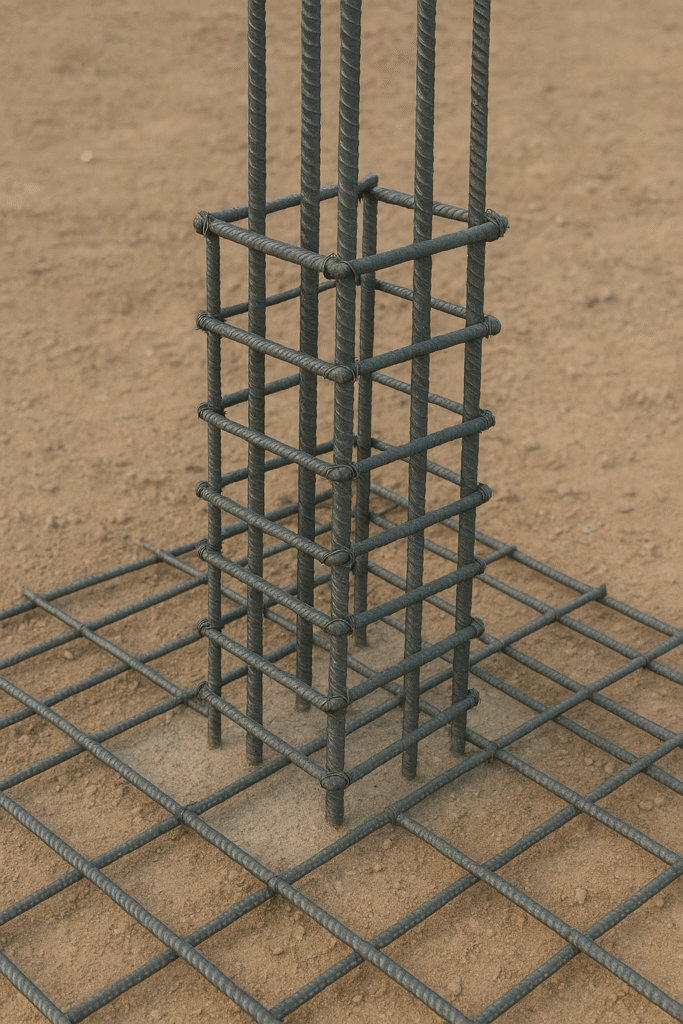Bar bending schedule of columns: Calculation, examples, and guide for engineers

Introduction
Concrete is strong in compression but weak in tension. That is why steel reinforcement is provided to carry tensile and shear stresses. Among reinforced concrete members, columns are one of the most important load-carrying elements in buildings and structures. The proper design and detailing of reinforcement in columns ensure safety, stability, and durability.
To execute reinforcement work efficiently on-site, engineers prepare a bar bending schedule of column. A BBS provides complete details of the reinforcement used in structural elements. Including bar size, number, length, shape, and weight. In this article we will explore everything you need to know about the bar bending schedule of columns, step by step, with examples and practical notes.
What is a bar bending schedule (BBS)?
A Bar Bending Schedule (BBS) is a tabular representation of reinforcement details used in reinforced concrete works. It is a detailed list showing:
- Bar Mark or identification number
- Type of construction (main bar, stirrup, tie, lap bar, etc.)
- Diameter of bar
- Length of each bar
- Shape of the bar with bending details
- Total length of reinforcement
- Total weight of reinforcement
BBS is prepared as per design drawings and codes (IS 2502:1963, 456:2000, BS 8666:2020, ACI 315, etc.).
Importance of The bar bending schedule of columns
1. Accurate Quantity Estimation – Prevents shortage or excess of steel
2. Cost Control—Helps in budgeting and minimizing wastage
3. Ease of Execution – Guides site engineers and bar benders.
4. Quality Assurance – Ensures reinforcement matches design
5. Standardization – Aligns with codes and contract documents.

Reinforcement in columns
Before preparing a bar bending schedule of columns, we need to understand typical reinforcement in columns:
1. Longitudinal Bars (Main Bars)
- Vertical bars are provided to resist axial loads and bending.
- Usually 12 16 mm, 20 mm or higher diameters
- Lapping is provided when bar length is insufficient.
2. Lateral Ties/Stirrups:
- Small-diameter closed-loop bars placed around longitudinal bars.
- Hold main bars in position and resist buckling
- Also improve ductility and confinement
3. Spiral Reinforcement (in circular columns):
- Instead of ties, spirals are used in circular columns.
- Provide better confinement and strength.
- Steps to Prepare Bar Bending Schedule of Columns
Step 1: Gather Inputs from Drawings
- Column dimensions (length, width, depth, or diameter).
- Height of column (story height).
- Cover requirements (usually 25–40 mm)
- Reinforcement details (no. of bars, bar diameters, tie spacing).
Step 2: Calculate Effective Lengths
- Effective length of main bars = clear column height + development length + lap length (if required).
- Length of lateral ties = perimeter of column (clear dimensions) + hook lengths.
Step 3: Determine Number of Bars
- Count the number of longitudinal bars as per the drawing.
- Calculate the number of stirrups = (clear height / spacing) + 1.
Step 4: Apply Standard Bending Formulas
- Hook Length (90° bend): 9ϕ
- Hook Length (135° bend): 16ϕ
- Development Length (Ld):
W=
Step 5: Prepare BBS Table
Include all bars with cutting length, quantity, and total weight.
Example: Bar Bending Schedule of a Rectangular Column
Column Date:
- Column size = 300 mm x 500 mm
- Height = 3 m (3000 mm)
- Cover = 40 mm
- Longitudinal reinforcement = 8 bars of 20 mm dia (4 at corners + 4 at sides)
- Lateral ties = 10 mm dia. @ 200 mm c/c
Step 1: Longitudinal Bars
- Effective height = 3000mm
- Development length = 40 × 20 = 800 mm each side
- Cutting length = 3000 + (2 × 800) = 4600 mm
Total = 8 bars × 4600 = 36,800 mm = 36.8 m
Weight = 36.8 × (20² / 162) = 36.8 × 2.47 = 90.9 kg
Step 2: Lateral Ties
- Clear inside dimensions = (300 – 2×40, 500 – 2×40) = 220 mm × 420 mm
- Tie length = 2(220 + 420) + 2 × 10ϕ – 3ϕ
= 2(640) + 200 – 30 = 1450 mm
- Number of ties = (3000 / 200) + 1 = 16 ties
Total length = 16 × 1450 = 23,200 mm = 23.2 m
Weight = 23.2 × (10² / 162) = 23.2 × 0.62 = 14.4 kg
Step 3: Total Steel in Column
- Main bars = 90.9 kg
- Ties = 14.4 kg
- Total Steel = 105.3 kg
Step 4: Final bar bending schedule of columns Table
| Bar Mark | Type of Bar | Dia (mm) | No. | Length (mm) | Shape | Total Length (m) | Weight (kg) |
| C1 | Longitudinal Bars | 20 | 8 | 4600 | Straight | 36.8 | 90.9 |
| C2 | Lateral Ties | 10 | 16 | 1450 | Closed | 23.2 | 14.4 |
Grand Total = 105.3 kg of reinforcement steel per column.
Example: BBS for Circular Column with Spiral
Column Data:
- Diameter = 400 mm
- Height = 3 m
- Cover = 40 mm
- Main bars = 8 bars of 16 mm dia
- Spiral reinforcement = 8 mm dia. @ 100 mm pitch
Step 1: Longitudinal Bars
- Cutting length = 3000 + (2 × 600) = 4200 mm
- Total = 8 × 4200 = 33.6 m
- Weight = 33.6 × (16² / 162) = 33.6 × 1.58 = 53.1 kg
Step 2: spur reinforcement
- Core diameter = 400 – (2 × 40) = 320 mm
- Spiral length per turn = π × 320 = 1005 mm
- Number of turns = 3000 / 100 = 30
- Total spiral length = 30 × 1005 = 30.2 m
- Weight = 30.2 × (8² / 162) = 30.2 × 0.395 = 11.9 kg
Step 3: Total Steel in Circular Column
- Main bars = 53.1 kg
- Spiral = 11.9 kg
- Total = 65 kg
Benefits of Preparing a Bar Bending Schedule of columns
- Saves 5–10% steel cost by reducing wastage.
- Provides a clear cutting and bending plan for fabricators
- Simplifies billing and auditing of steel consumption
- Enhances quality control by ensuring reinforcement complies with design
- Help in construction scheduling and site management
Software Tools for bar bending schedule of columns
- Manual BBS preparation is time-consuming. Engineers often use software like
- MS Excel/Google Sheets (custom BBS templates)
- Autocad with add-ons for automatic bar length extraction
- STAAD, ETABS, Tekla, and Revit generate reinforcement schedules directly.
- These tools reduce errors and save valuable time.
Practical tips for bar bending schedule of columns
- Always deduct clear cover while calculating stirrup/tie lengths
- Provide hooks of proper length as per IS 2502 or BS 8666.
- For tall columns, consider lap lengths (usually 40–50ϕ)
- Ensure stirrup spacing is reduced near supports (as per IS 456)
- Double-check bar diameter—a common site mistake is mixing 12 mm with 16 mm bars
- Html
Conclusion
The bar bending schedule of columns is a vital tool in construction management. By calculating the exact quantity of reinforcement. It ensures cost-effectiveness, reduces wastage, and guarantees structural safety. Whether for rectangular columns with ties or circular columns with spirals, the process involves calculating bar lengths, considering development lengths, and compiling them into a structured BBS table
For engineers, mastering BBS is an essential skill that bridges the gap between design and site execution. With digital tools and proper knowledge, preparing accurate The bar bending schedule of columns can save significant time, material, and money while ensuring structural reliability.






